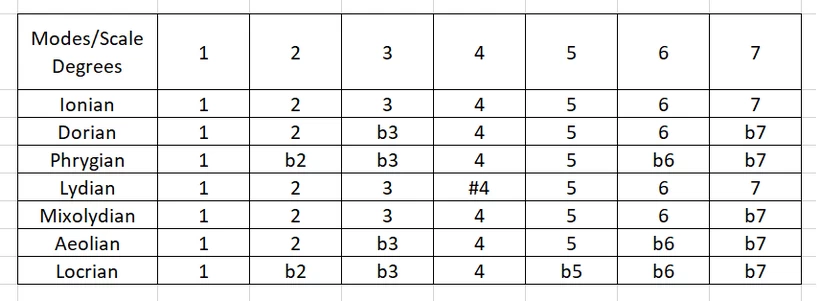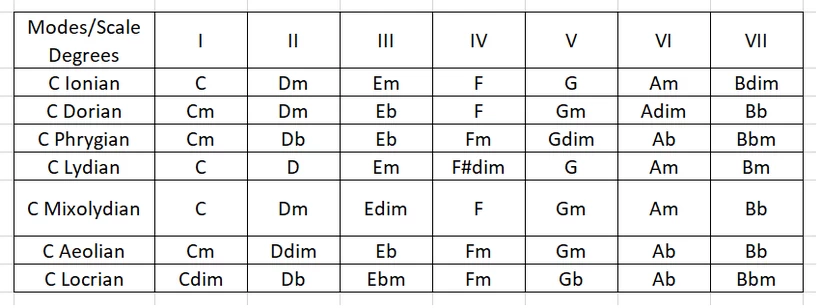Do you want to understand and incorporate mode mixtures or borrowed chords in your music?
They can spice up your music by providing an unexpected variation to the listeners. These chords are borrowed from the parallel modes, which means the scales or modes that have the same tonic note as the key you are currently in.
This article will provide detailed information about the music theory and concepts behind the formation of these chords, their purpose, uses, chord progressions, what parallel modes you can use to borrow the chords, etc.
Read the article till the end to know all this and more!
What is A Borrowed Chord Or Modal Mixtures?
There are many names for Borrowed Chords, like Modal Mixtures, Mode Mixtures, Mutation, Modal Interchange, and Substituted Chords.
They all refer to borrowing a chord from a parallel scale or mode. As you may know, a parallel scale, also known as the parallel mode, has the same tonic root but different intervals and notes.
The parallel major and minor keys have the same tonic note. C Minor and C major Scales are examples of these. There are three minor scales in addition to the major scale that forms parallel scales apart from the parallel modes – the natural minor scale, the melodic minor scale, and the harmonic minor scale.
It is also possible to borrow the chords from other parallel modes besides the parallel key. For example, D Major and D Dorian.
If you are unfamiliar with modes, we suggest going through our article on Diatonic Modes.
Purpose of Borrowing Chords
The chords are borrowed to add color to the music. They add to the harmonic variety through the use of contrasting scales. They give you something you expect and mix it with something you don’t expect.
The use of the borrowed chords is for a brief time and does not qualify for modulation. They provide the sound of their parent mode without actually switching to it.
You must understand that they do not carry out any secondary function like secondary dominants or secondary leading tone chords, as they do not tonicize any particular chord.
Borrowed Chords / Modal Mixture Music Theory
Theoretically, you have the option of borrowing any chord from any mode of the scale you are in, but as always, some chords are frequently borrowed because they sound good, while borrowing of others is rare. Let us look at some of the common borrowed chords in the following sections and the music theory behind them.
Major and Minor Scales
The table below shows the diatonic chords from harmonizing the major and minor scales. As you can see, the sonorities or the chord qualities between the two scales are different from each other.
Major Scale Chords
| Scale Degrees | 1 | 2 | 3 | 4 | 5 | 6 | 7 |
|---|---|---|---|---|---|---|---|
| Chord Quality | Major | minor | minor | Major | Major | minor | dim |
| Roman Numeral Notation | I | ii | iii | IV | V | vi | viidim |
| Scale Degree Names | Tonic | Super-Tonic | Mediant | Sub-Dominant | Dominant | Sub-Mediant | Leading Tone |
Natural Minor Scale Chords
| Scale Degrees | 1 | 2 | 3 | 4 | 5 | 6 | 7 |
|---|---|---|---|---|---|---|---|
| Chord Designation | i | iidim | III | iv | v | VI | VII |
| Chord Quality | minor | diminished | Major | minor | minor | Major | Major |
In particular, observe the triad chords formed with the scale degree 5 and 7 notes as the root in the minor key. These chords are v (minor) and VII (Major) as per the roman numerals nomenclature.
In common practice, we use V and viio chords for these scale degrees by raising the 7th note of the scale to the leading tone instead of a subtonic. This result in Harmonic minor scales.
Technically, by raising the 7th, we are knowingly or unknowingly using a mode mixture as we are using a chord borrowed from the parallel scale (Harmonic Minor or the Major Scale). It is so commonly done that it is not considered a mode mixture by most anymore.
Other than the above, it is more common for the major keys to borrow chords from its parallel minor key. As you know, a natural minor scale can be derived from a major scale by lowering the 3rd, 6th, and 7th notes.
In the following few sections, you will see the impact of these changes in the order of their popularity and usage. This means lowering b6 is the most common, followed by b3, with b7 being the least used.
Lowering the Scale Degree 6 Note (b6)
Lowering the 6th note from a major scale or borrowing a chord from a scale having a lowered 6th gives you access to a minor iv chord, an ii diminished triad, an ii half diminished 7th chord, and a vii fully diminished 7th chord. These sonorities usually are not available in a major key. You will get the variation in the chord quality without changing the root note.
Lowering the Scale Degree 3 Note (b3)
This change allows you to use a minor i chord, a minor iv7 chord, and a bVI chord. You need to be careful while using the minor i chord instead of the major tonic chord because that is what the listeners are expecting for resolution. A bVI chord also requires a lowered scale degree of 6, along with 3.
In the previous section, you had seen that by borrowing the chords from the parallel key, you could change the chord’s quality without changing the root.
But in the case of chords like bVI, you change the root by lowering it by a semitone. This change results in the formation of non-diatonic chords. Note that you are introducing an accidental in the Roman numeral analysis for this chord, which you have not done so far. You were only changing the case of the representation to denote minor or major chords.
Consider the vi in the C major scale, the A minor chord. It has notes A, C, and E. When you lower the scale degree 6, A changes to Ab.
The notes of the new chord formed by lowering scale degrees 3 and 6 are Ab, C, and Eb, and it is now a major chord designated as bVI. The changes are in the root & the 5th note (lowered to b6 – 1 – b3) and the quality (converted to major).
The bVI chord exists in the Aeolian and the Phrygian mode, as we will see later.
Lowering the Scale Degree 7 Note (b7)
Lowering the 7th scale degree results in the formation of the bIII and bVII chords. The bVII chord is also part of the Mixolydian mode.
The only mode mixture that is hard to find is the use of the v chord instead of the V, the dominant chord.
Picardy Third
So far, you have seen the chords borrowed from the minor key, except for the V and viio chords. Picardy third is an example of borrowing a major chord from parallel keys in a minor mode. You use the progression V – I in the minor key instead of the usual V – i.
This was commonly used by Beethoven in a number of his compositions. This change does not work in a reverse way. This is due to the simple fact that major tonic triads have a better resolution than minor ones due to the sympathetic vibrations.
Summarizing the Changes
You can see the summary of the abovementioned changes in the following examples in C major. The C major scale has notes [C D E F G A B] and C minor [C D Eb F G Ab Bb] with a lowered 3rd, 6th, and 7th.
Use of b6:
The iv chord – Notes [F Ab C] from the C minor, or [4, b6, 1].
The iio & iiØ7 chords – Notes [D F Ab] and [D F Ab C]. This is equivalent to [2, 4, b6] & [2, 4, b6, 1].
The viio7 chord – Notes [B D F Ab] or [7, 2, 4, b6].
Use of b3 and/or b6:
The i Chord – Notes [C Eb G] or [1 b3 5].
The iv7 seventh chords – Notes [F Ab C Eb] or [4, b6, 1, b3].
The bVI chord – Notes [Ab C Eb] or [b6, 1, b3].
Use of b7 and/or b6 & b3:
The bIII chord: Notes [Eb G Bb] or [b3, 5, b7].
The bVII chord: Notes [Bb D F] or [b7, 2, 4].
Borrowed Chord Progressions
Let us see examples of borrowed chords and modal mixtures between the major and minor scales in the actual chord progressions.
Minor iv Chord
Let us consider the chord progression I – vi – IV – ii – V – I in the key of C Major. If instead of the Major IV chord, the F major, you want to use the F minor, you have a borrowed chord from the parallel minor mode.
To convert an IV chord to an iv chord, you need to lower the scale degree 6 note by a half step, precisely what a parallel minor scale (natural) does.
The iiØ7
Let us consider the same example above and now change the ii chord to iiØ7, resulting in I – vi – IV – iiØ7 – V – I.
The bIII, bVI, and bVII Chords
You can change the vi to bVI in our earlier example to get the I – bVI – IV – ii – V – I progression. In rock music, the progressions I – bVII – bVI – bVII and I – bVI – IV are very common and have been used by popular bands like Genesis, Nirvana, and Yes. In addition, the use of bVI – I, bVII – I, and I – bIII – I progressions from these major chords to the tonic chord is very common.
Voice Leading of the Borrowed Chords
Like any other chord progressions, the chord tones must resolve smoothly.
Most b6 variations are prepared or approached by a step and resolved by a step in the downward direction. Note that all these variations have a certain level of dissonance, and you can’t simply jump into them without any preparation. The dissonance has to be resolved by the end of the phrase or the period.
Do not double the accidental or varied notes unless they are the root of the chords.
Borrowed chord chart
Our article on the Diatonic modes summarized the different modes of the major scales and their notes which are reproduced in the table below:

The triad chords formed by harmonizing these modes with C as their tonic is given in the table below. You can see that every mode results in 3 major triads, 3 minor triads, and one diminished triad.

The table below shows the 7th chords formed by the harmonization of these modes with C as their tonic. Note that as you come down a mode in the given order, the quality of the chord shifts by one column to the left.

For example, C Ionian has degree II and III chords as minor. C Dorian has degrees I and II as minor chords. See the movement of half-diminished chord m7(b5) from degree 7 to 6 to 5 and so on up to 1.
Conclusion
We hope that the concepts of mode mixture and the borrowed chords are now clear to you and you will be able to use them in your music. If you still have any doubts or require further elaboration, feel free to write to us in the comments section below.
